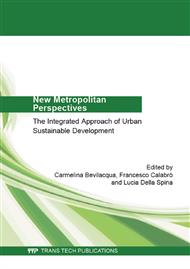[1]
While this paper was being written, the Sicilian Regional Assembly rejected the Draft Law providing for the establishment of the metropolitan city of Messina. Beyond any legal and institutional aspect, which is not dealt with in this paper, the role of the two cities is deemed crucial to enhance the Strait Area so that it can acquire strategic importance in the Euro-Mediterranean context as the heart of a wider territorial platform in the south of Italy.
Google Scholar
[2]
Information on http: /ec. europa. eu/europe2020/index_en. htm.
Google Scholar
[3]
European Union-Regional Policy: Cities of tomorrow. Challenges, vision, ways forward, European Union, October (2011).
Google Scholar
[4]
Information on http: /ec. europa. eu/regional_policy/sources/docoffic/working/regions2020/ index_en. htm.
Google Scholar
[5]
Issues paper for discussion in the forum CITIES-Cities of Tomorrow: Investing in Europe", Brussels 17-18 February 2014, Information on http: /ec. europa. eu/regional_policy/newsroom/detail. cfm, LAN=it&id=1284&lang=it.
Google Scholar
[6]
R. Camagni, S. Lombardi (Eds. ): La città metropolitana: strategie per il governo e la pianificazione, Alinea, Firenze (1999).
Google Scholar
[7]
A. M. Colavitti: Governance del territorio. Beni Culturali. Piano urbanistico. Buone pratiche per la valorizzazione e la competitività, Alinea, Firenze (2013).
Google Scholar
[8]
A. Granelli: Città intelligenti? Per una via italiana alle Smart Cities, Luca Sossella Editore, Roma (2012).
Google Scholar
[9]
C. Landry: The creative city: a toolkit for urban innovators, Earthscan, London (2000).
Google Scholar
[10]
R. Florida: Cities and the Creative Class, Routledge, New York (2004).
Google Scholar
[11]
European Commission: The EU Framework Programme for Research and Innovation. Horizon 2020. Excellent Science Competitive Industries Better Society. EU Research and Innovation: Tackling Societal Challenges, Information on http: /ec. europa. eu/programmes/horizon2020.
Google Scholar
[12]
C. Pacente: La città metropolitana nell'UE. Programmazione comunitari, esperienze europee a confronto e nuove prospettive, Egea/Bocconi, Milano (2013).
Google Scholar
[13]
Urban Audit and Eurostat, Information on http: /www. eurometrex. org/ENT1/EN/About/about_METREX. php.
Google Scholar
[14]
Information on http: /www. cittalia. it/index. php?option=com_k2&view=item&id=5048: citta-metropolitane-rapporto-cittalia-le-cifre-del-divario-tra-grandi-citta-e-cinture-urbane&Itemid=435.
Google Scholar
[15]
Information on http: /capacitaistituzionale. formez. it/content/presentato-programma- operativo-nazionale-citta-metropolitane.
Google Scholar
[16]
European Straits Initiative-ESI, Information on http: /www. europeanstraits. eu.
Google Scholar
[17]
J. Gambino: Profili geopolitici dell'Area metropolitana dello Stretto, in: G. Tuccio (Ed. ), Reggio Città metropolitana nell'area metropolitana dello Stretto, Iiriti, Reggio Calabria, (2013) pp.297-323.
DOI: 10.3280/asur2019-124001
Google Scholar
[18]
P. Casavola, C. Trigilia: La nuova occasione. Città e valorizzazione delle risorse locali, Donzelli Editore, Roma (2012).
Google Scholar
[19]
F. Moraci: Costruire la città metropolitana di Reggio Calabria; fattori di metropolitanizzazione e creatività come dimensione strategica della politica urbana, in G. Tuccio (Ed. ), Reggio città metropolitana nell'area metropolitana dello Stretto, Iiriti editore, Reggio Calabria (2013).
DOI: 10.17660/th2020/75.4.4
Google Scholar
[20]
Provincia di Reggio Calabria-Commissione Tecnico-Scientifica Rete E.S.I. (European Straits Initiative): La Rete E.S.I. e i Fondi Strutturali 2014-2020: una strategia condivisa per lo sviluppo sostenibile dell'area dello stretto, Documento Preliminare, Reggio Calabria, giugno (2013).
Google Scholar


